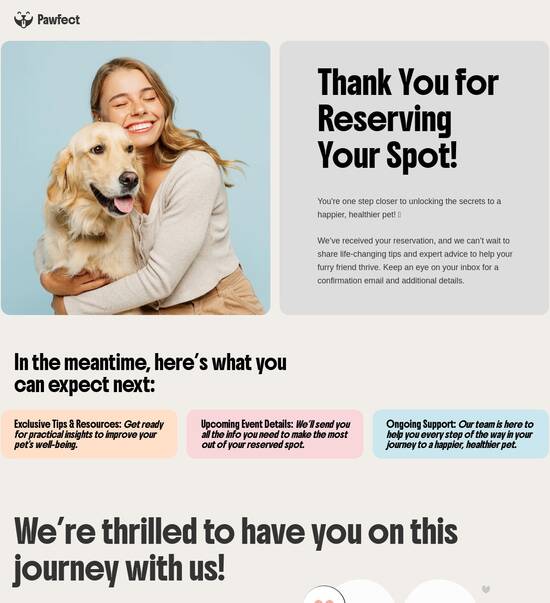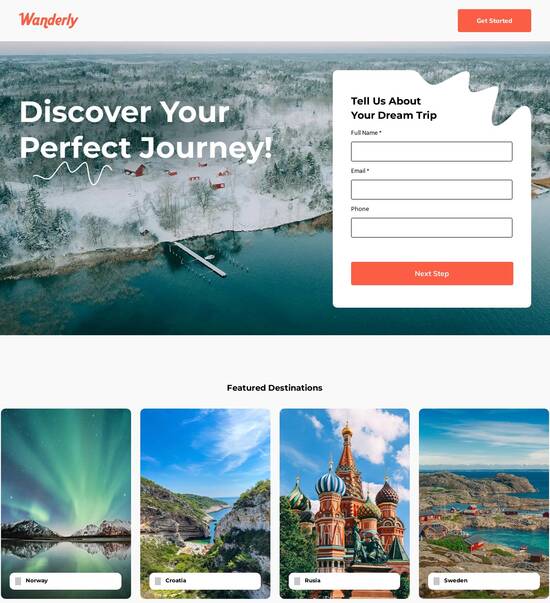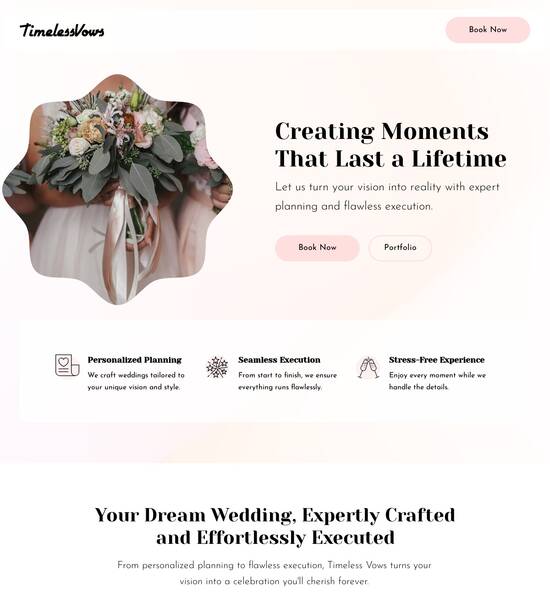
HTML page template with interactive testimonial widget
Explore Similar TemplatesAbout template
Use HTML page templates with interactive testimonial widget and make your communications easy and transparent. Try our solution today.
Recommended templates

Easy to build without coding
With the intuitive drag-and-drop builder, anyone on your team can create high-converting pages without any knowledge of code or design. Make enhancements to your landing page with custom widgets using Javascript, HTML/CSS, or third-party scripts.

Multiple layouts for any industry and goal
Select from 500+ landing page layouts built to boost conversions across industry-specific scenarios. Customize them by adjusting fonts, adding images, and generating on-brand content with the AI assistant. Quickly scale with Instablocks® and Global Blocks that you can save, reuse, and update globally.

Loads fast and looks polished on any device
Every template is responsive, which means they present professionally on any device and load blazingly fast with our Thor Render Engine. You can also power them up with Google AMP technology to deliver an unparalleled mobile experience and drive higher conversions.

Robust analytics & experimentation
Get real-time updates and reporting across all your devices, showing the number of visitors, conversions, cost-per-visitor, and cost-per-lead. Launch AI-powered experiments, run A/B tests, and use heatmaps to analyze user behavior, then optimize your landing page to maximize conversions.







Easy to build without coding
With the intuitive drag-and-drop builder, anyone on your team can create high-converting pages without any knowledge of code or design. Make enhancements to your landing page with custom widgets using Javascript, HTML/CSS, or third-party scripts.
Multiple layouts for any industry and goal
Select from 500+ landing page layouts built to boost conversions across industry-specific scenarios. Customize them by adjusting fonts, adding images, and generating on-brand content with the AI assistant. Quickly scale with Instablocks® and Global Blocks that you can save, reuse, and update globally.
Loads fast and looks polished on any device
Every template is responsive, which means they present professionally on any device and load blazingly fast with our Thor Render Engine.
Robust analytics & experimentation
Get real-time updates and reporting across all your devices, showing the number of visitors, conversions, cost-per-visitor, and cost-per-lead. Launch AI-powered experiments, run A/B tests, and use heatmaps to analyze user behavior, then optimize your landing page to maximize conversions.
All the features you need to build lead-generating landing pages
Explore more featuresLearn how to build top-performing landing pages for any goal
FAQs
Leading the way in building high-performing landing pages





A comprehensive guide to using Instapage for optimizing your landing pages
Instapage is your ultimate ally in creating high-converting landing pages that drive results. With our extensive library of templates and user-friendly tools, marketers can easily accelerate their campaigns and optimize ROI. This guide will take you through the essential steps to enhance your digital marketing strategies using Instapage's powerful features.
Understanding the importance of landing pages
Landing pages are critical components of any digital marketing campaign. They serve as focused destinations tailored to convert visitors into leads or customers. A well-designed landing page not only improves your marketing effectiveness but also enhances user experience, encouraging potential clients to trust your brand.
- Conversion rates: High-quality landing pages significantly boost conversion rates by focusing messaging and content towards specific goals.
- User engagement: Engaging landing pages result in longer visitor durations and lower bounce rates.
- Brand consistency: Cohesive landing pages enhance brand visibility and help maintain messaging uniformity across campaigns.
Step 1: Choosing the right template
To get started, select a template that resonates with your campaign objectives. Instapage offers over 100 high-converting templates that can be customized to fit your needs. Choosing the right template is crucial as it sets the tone and structure of your landing page.
- Industry relevance: Ensure your template matches your business vertical, whether it's tech, education, or financial services.
- Goal alignment: Pick templates designed to drive specific actions, such as lead generation or product sales.
- Customization flexibility: Choose a template that allows for easy modifications to cater to different audience segments.
Step 2: Optimizing for conversions
Once your template is selected, leverage Instapage’s built-in optimization tools. Start by adding trust elements like testimonials and security badges to build credibility. Additionally, make use of A/B testing to identify layout variations that enhance conversion rates.
- A/B testing: Experiment with different headlines, images, and calls to action to find out what drives the best response.
- Heatmaps: Utilize heatmaps to visualize user behavior and adjust elements accordingly to improve engagement.
- Analytics dashboard: Monitor performance metrics and adjust your approach based on real-time insights.
Step 3: Personalized content delivery
Creating personalized experiences can significantly affect engagement and conversion rates. Use dynamic text replacement to tailor content to the visitor's interests or previous interactions. Furthermore, personalize landing pages based on ad clicks or segment them further for diverse audience needs.
By following these steps, you will be well on your way to crafting high-performing landing pages with Instapage that enhance user experience and maximize conversion rates.
Ready to elevate your marketing campaigns? Start using Instapage today to create engaging, conversion-focused landing pages that resonate with your audience.
People also ask about HTML page template with interactive testimonial widget
Unveiling the Interactive Testimonial Widget: Transforming HTML Page Templates
Understanding the role of testimonials in modern web design
Testimonials play a crucial role in web design by influencing how potential customers perceive a brand. From small businesses to large corporations, the integration of authentic user feedback helps establish credibility and trust. When users see positive experiences shared by others, especially those who echo their own situation, they are more likely to consider the product or service.
Social proof is a powerful motivator, psychologically reassuring potential buyers that they are making the right decision. This trust can significantly impact conversion rates. When prospective customers see reviews that resonate with their expectations, they are more inclined to proceed with purchases, thereby influencing user decisions.
Building trust through social proof
Influencing user decisions with relatable feedback
User-generated content is equally important in today’s digital marketing landscape. Genuine reviews can lead to higher engagement rates and conversions. By curating authentic experiences from actual users, businesses can create a community around their brand and foster loyalty, making testimonials not just nice-to-have features but essential components of effective online marketing strategies.
Exploring the fundamentals of an HTML page template
An HTML page template acts as a foundation for creating web pages. It includes essential components such as divisions, headers, and footers, ensuring every part of the page is organized for optimal user experience. By understanding these elements, marketers and developers can create aesthetically pleasing and functional landing pages that cater to their audience's needs.
Moreover, CSS is critical for styling, giving an appealing look to the layout. This adds visual hierarchy and helps guide the user’s eye toward significant content areas. Further, ensuring responsiveness is vital in today’s mobile-driven market; templates must adapt seamlessly across devices, from desktop to smartphones, optimizing user experience regardless of the platform.
Structure: Divisions, headers, and footers
Styling: CSS for a polished look
Responsiveness: Ensuring adaptability across devices
Clean code is another critical aspect to consider when developing a template. Well-structured code enhances loading speeds while also improving SEO performance. Clean, organized code allows for quick design updates and customizations, making future adjustments much more manageable.
The interactive testimonial widget: A game-changer
The interactive testimonial widget represents a significant evolution in how testimonials are presented on websites. Unlike static testimonial displays, which merely present text reviews, this widget encourages user interaction. Visitors can engage with the testimonials—voting on their usefulness, commenting on them, or sharing their own feedback, creating an engaging user experience that fosters community.
This interactive component not only enhances user engagement but also provides valuable insights back to businesses. Marketers can gauge which testimonials resonate most with their audience, refining their approach based on these interactions. Further, the user feedback shown on these widgets adds a layer of authenticity, as it reflects real-time opinions rather than curated lists that may feel insincere.
Responsive testimonials slider: Seamless user experience on all devices
User interaction options: Voting, commenting, and sharing testimonials
Elements of a comprehensive testimonial widget
For a testimonial widget to be effective, it must feature several key attributes. First and foremost, testimonials should exude realism. Authentic user feedback resonates more with potential customers when it comes from individuals who appear relatable and trustworthy. Secondly, visuals play a significant role; incorporating users' pictures alongside their testimonials boosts credibility, making the feedback feel more genuine.
Including attribution, such as the author’s name, further enhances authenticity. Shoppers are more inclined to trust feedback that attributes ratings to real individuals rather than anonymous or generic entries. Additionally, most brands will want to customize the widget's appearance to maintain brand consistency; integrating logos and using matching font and color schemes allows the widget to blend seamlessly into the overall aesthetic of the website.
Realism: Genuine user feedback that resonates
Visuals: Incorporating users' pictures to enhance credibility
Attribution: Including author names for authenticity
Customizability is essential to create a unified look across a website. The ability to integrate logos and tailor fonts and colors allows brands to maintain coherence across all pages, ensuring a professional appearance.
Implementing the responsive testimonials slider
Creating a responsive testimonials slider is a structured process that begins with sourcing authentic user feedback. Brands can collect real-user reviews through surveys, reaching out post-purchase, or utilizing social media platforms. This data serves as the foundation for the testimonials carousel, presenting users with diverse opinions that speak to potential customers’ concerns.
Next, developers need to code the HTML structure carefully to ensure compatibility with the interactive widget. Clean, organized code is vital not only for functionality but also for enhancing site speed. It is paramount that the testimonials slider is responsive, which means it should adapt fluidly to all device sizes, ensuring that all users, regardless of their browsing method, have a satisfying experience.
Sourcing user feedback: Where to find authentic reviews
Coding the HTML structure: Ensuring compatibility with the widget
Emphasizing mobile-first design is crucial, as the majority of online users access websites via mobile devices. Techniques such as fluid grids, flexible images, and media queries should be integrated into the design. These approaches help to ensure fluidity and ease of navigation, maximizing engagement and minimizing potential frustration for users.
Strategic placement of the testimonial widget on your site
The placement of the testimonial widget is critical in maximizing its impact on user engagement. While some believe positioning it above the fold can capture attention immediately, others argue for placing it below the fold to provide more context. Understanding the pros and cons of each position can provide insights into effectively utilizing this powerful tool in different contexts.
Integrating testimonials into landing pages is an effective best practice for conversions. When users arrive at a landing page for the first time, seeing authentic user experiences can comfort hesitant visitors and encourage decision-making. Certain sections of the website are ideal for testimonials, like the homepage, which helps instill trust in first-time visitors, or product pages, where positive reviews can actively drive sales.
Above the fold vs. below the fold: Weighing pros and cons
Integrating into landing pages: Best practices for conversions
Utilizing testimonials across different website sections can further amplify their effect. For example, including testimonials on the homepage can help establish rapport with new visitors, while embedding them on product pages directly influences purchasing decisions, thereby improving overall conversion rates.
Collecting and displaying user reviews effectively
Collecting user feedback can be approached through various strategies. Running surveys and conducting follow-ups post-purchase not only helps brands gather data but also creates touchpoints with their customers. Additionally, utilizing social media as a platform for collecting reviews creates an opportunity for businesses to engage with their audience directly and gather authentic experiences.
Once collected, presentation becomes paramount. Users are attracted to visually appealing displays that showcase feedback creatively. Using quotes, images, and ratings in an engaging manner can significantly enhance the utility of user experiences. Rotating testimonials is also beneficial, keeping content fresh and ensuring returning visitors see new opinions without repeating the same testimonials.
Running surveys and follow-ups post-purchase
Utilizing social media to collect reviews and testimonials
By focusing on both the quantity and quality of user feedback displayed, brands can improve user trust and engagement.
SEO benefits of using an interactive testimonial widget
User reviews can significantly contribute to search engine rankings. Fresh content is a key component of effective SEO strategies, and regularly updated testimonials can add to a site’s relevancy. Furthermore, integrating local SEO advantages, such as featuring local customer testimonials, can enhance visibility in search engine results, effectively drawing more traffic to the website.
Implementing schema markup for reviews is an excellent strategy as it improves visibility in search results. By enabling rich snippets, companies can increase click-through rates and enhance user engagement. This necessitates a strategic approach to integrating testimonial content since it can yield long-term benefits for overall website performance.
How user reviews contribute to search rankings
Implementing Schema Markup for reviews
Analyzing the impact of testimonials on user engagement
Measuring the effectiveness of testimonials involves monitoring several key metrics. Tracking conversion rates before and after implementing the widget can showcase its impact on user decisions. Likewise, analyzing engagement metrics, including time spent on the site and interaction rates with the testimonial widget itself, helps in understanding its effectiveness.
Continual improvement is essential; this can be done through user feedback and A/B testing different configurations of testimonials. Testing various placements, presentation styles, and types of content allows for an iterative process that enables marketers to refine their approach based on real user preferences and trends.
Conversion rates before and after widget implementation
Engagement analytics: Time on site and interaction rates
Finding support and solutions for widget integration
Navigating the inquiry support center can provide solutions to common challenges that arise during the integration of interactive testimonial widgets. Users often have questions and need support to address issues effectively. Utilizing available resources can streamline troubleshooting and optimization processes.
For businesses looking to enhance customization further, partnering with web development firms could be beneficial. These experts can provide tailored solutions that meet specific needs while ensuring that the testimonial widget aligns perfectly with the overall website functionality. This collaboration can be particularly helpful for those seeking ongoing support to maintain long-term viability.
Common challenges and their solutions
Resources available for troubleshooting and optimization
Future trends in interactive testimonials
Emerging technologies will likely continue to shape the landscape of how testimonial widgets operate. With advancements in artificial intelligence, there is significant potential for creating personalized user experiences based on behavior and preferences. Predicting future enhancements to user feedback mechanisms, such as more interactive features, will cater to evolving user expectations.
Moreover, businesses must adapt to changing user needs. As the digital landscape grows more competitive, innovating in social proof and feedback mechanisms will be vital for maintaining relevance. Companies that consistently focus on enhancing their customer relationships through improved testimonial functionality will likely see an uptick in customer trust and loyalty.
Integration of AI and personalized user experiences
Predictions for future enhancements in user feedback mechanisms
Ready to skyrocket conversions?
Supercharge your ad campaigns with high-performing landing pages
Get started














